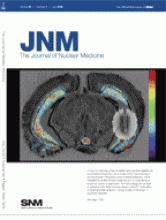Abstract
For a PET agent to be successful as a biomarker in early clinical trials of new anticancer agents, some conditions need to be fulfilled: the selected tracer should show a response that is related to the antitumoral effects, the quantitative value of this response should be interpretable to the antitumoral action, and the timing of the PET scan should be optimized to action of the drug. These conditions are not necessarily known at the start of a drug-development program and need to be explored. We proposed a translational imaging activity in which experiments in spheroids and later in xenografts are coupled to modeling of growth inhibition and to the related changes in the kinetics of PET tracers and other biomarkers. In addition, we demonstrated how this information can be used for planning clinical trials. Methods: The first part of this concept is illustrated in a spheroid model with BT474 breast cancer cells treated with the heat shock protein 90 (Hsp90) inhibitor NVP-AUY922. The growth-inhibitory effect after a pulse treatment with the drug was measured with digital image analysis to determine effects on volume with high accuracy. The growth-inhibitory effect was described mathematically by a combined Emax and time course model fitted to the data. The model was then used to simulate a once-per-week treatment; in these experiments the uptake of the PET tracers 18F-FDG and 3′-deoxy-3′-18F-fluorothymidine (18F-FLT) was determined at different doses and different time points. Results: A drug exposure of 2 h followed by washout of the drug from the culture medium generated growth inhibition that was maximal at the earliest time point of 1 d and decreased exponentially with time during 10–12 d. The uptake of 18F-FDG per viable tumor volume was minimally affected by the treatment, whereas the 18F-FLT uptake decreased in correlation with the growth inhibition. Conclusion: The study suggests a prolonged action of the Hsp90 inhibitor that supports a once-per-week schedule. 18F-FLT is a suitable tracer for the monitoring of effect, and the 18F-FLT PET study might be performed within 3 d after dosing.
Footnotes
-
COPYRIGHT © 2008 by the Society of Nuclear Medicine, Inc.







